dress,wear,put on,have on,in用法总结
wear-put-on--dress---in---with用法
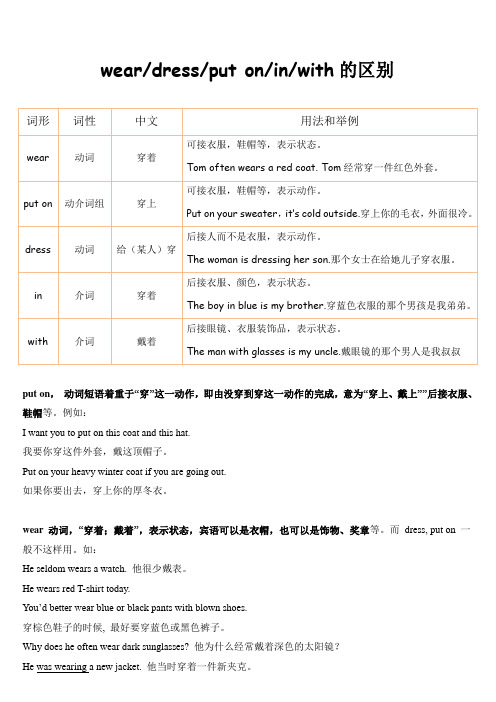
wear/dress/put on/in/with的区别put on,动词短语着重于“穿”这一动作,即由没穿到穿这一动作的完成,意为“穿上、戴上””后接衣服、鞋帽等。
例如:I want you to put on this coat and this hat.我要你穿这件外套,戴这顶帽子。
Put on your heavy winter coat if you are going out.如果你要出去,穿上你的厚冬衣。
wear 动词,“穿着;戴着”,表示状态,宾语可以是衣帽,也可以是饰物、奖章等。
而dress, put on 一般不这样用。
如:He seldom wears a watch. 他很少戴表。
He wears red T-shirt today.You’d better wear blue or bla ck pants with blown shoes.穿棕色鞋子的时候, 最好要穿蓝色或黑色裤子。
Why does he often wear dark sunglasses? 他为什么经常戴着深色的太阳镜?He was wearing a new jacket. 他当时穿着一件新夹克。
Such clothes are not often worn nowadays. 现在那样的衣服很少有人穿了。
dress 动词,常用人作宾语,不接“衣”作宾语,意为“给……穿衣服”。
在表示“自己穿衣”时可说get dressed (= dress oneself)。
当dress表示状态时,一般要用be dressed in形式。
dress up强调着意打扮,意为“穿上盛装、乔装打扮”。
例如:My son is now able to dress himself. 我儿子现在自己会穿衣服了。
It’s time to wake up and get dressed! 该起床穿衣服了。
She is dressed in a fur coat. 她穿着毛皮大衣。
怎样正确使用“穿”

怎样正确使用“穿”在英语中“穿”有很多种说法,wear,dress,puton,haveon,in,on穿戴这几个词在汉语中的用法较为简单,但在英语中有些复杂。
初中学生要想做题时得心应手,就要搞清上列几个“穿”的用法。
(1)wear和haveon穿着;戴着。
相当于及物动词,有衣物作宾语,着重于穿、戴的状态。
haveon不用于进行时态。
①Healwayswears/hasonblackshoes.她一直穿着黑鞋。
②Sheiswearing/hasonaredcoat她穿着红大衣。
wear是“穿,戴”的意思。
牛津英语第9页有个句子:Danieloftenwearsglasses.这里的wear是戴眼镜的意思。
MissGaooftenwearsasmileonherface.这里的wear是面带微笑的意思。
wear作为“穿,戴”通常表示一种穿着状态。
如:Nancyiswearingabluecoattoday.该处虽然用的是一般现在时,但却并不表示动作正在发生,而是一种状态,翻译成Nancy今天穿着一件蓝色的外套。
(2)dress有两个基本意义,一个是名词裙子,衣服,另一个是动词,给某人穿衣。
dress穿;戴。
可用作及物动词,以人作宾语,dress作为动词时,常构成几个词组: dressup(打扮),dressupin(穿),dresssb.(给某人穿衣), bedressedin(穿),特别要注意的是dresssb.,这个词组常被学生遗忘.即dresssb.(给某人穿衣);也可用作不及物动词。
既可强调动作,又可表示状态,表示状态时常用bedressedin结构。
此外dress还可用作名词。
①Maryisdressingherdaughter.玛丽正给她女儿穿衣服。
②Sheusuallydresseswell.她总是穿得很好。
③Heisdressedinablackjacket.他穿着黑上衣。
(3)in穿着;戴着。
中考in,put on,wear,dress, have on, pull on 用法辨析
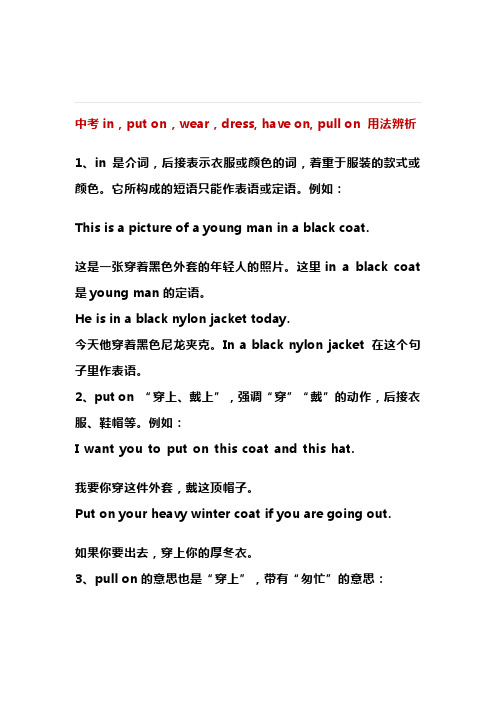
中考in,put on,wear,dress, have on, pull on 用法辨析1、in是介词,后接表示衣服或颜色的词,着重于服装的款式或颜色。
它所构成的短语只能作表语或定语。
例如:This is a picture of a young man in a black coat.这是一张穿着黑色外套的年轻人的照片。
这里in a black coat 是young man的定语。
He is in a black nylon jacket today.今天他穿着黑色尼龙夹克。
In a black nylon jacket 在这个句子里作表语。
2、put on “穿上、戴上”,强调“穿”“戴”的动作,后接衣服、鞋帽等。
例如:I want you to put on this coat and this hat.我要你穿这件外套,戴这顶帽子。
Put on your heavy winter coat if you are going out.如果你要出去,穿上你的厚冬衣。
3、pull on的意思也是“穿上”,带有“匆忙”的意思:It’s the weekend. I know you’re free. So pull on your jeans and come out with me.现在是周末,我知道你有空。
所以穿上你的牛仔裤,和我一起出去吧。
You’re late! Quickly pull on your clothes and leave!你迟到了!快穿上衣服走吧!4、wear “穿着;戴着”,表示状态,宾语可以是衣帽,也可以是饰物、奖章等。
例如:You’d better wear blue or black pants with blown shoes.穿棕色鞋子的时候, 最好要穿蓝色或黑色裤子。
Why does he often wear dark sunglasses?他为什么经常戴着深色的太阳镜?5、dress的宾语通常是人,意思是“给……穿衣服”。
常用动词辨析及常见多义词
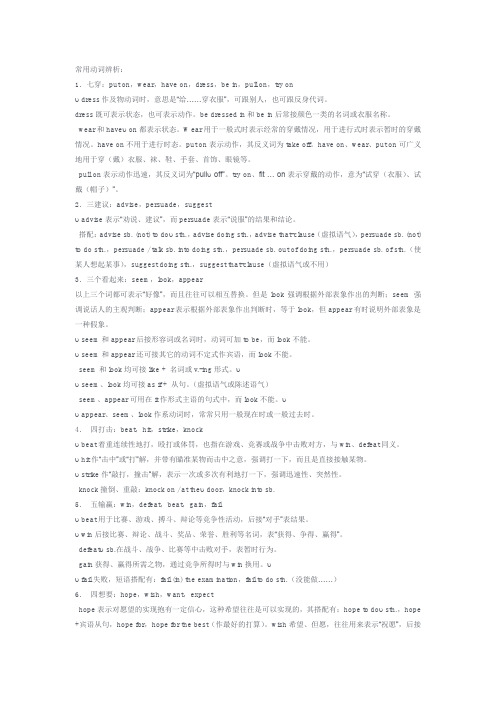
常用动词辨析:1.七穿:put on,wear,have on,dress,be in,pull on,try onυ dress作及物动词时,意思是“给……穿衣服”,可跟别人,也可跟反身代词。
dress既可表示状态,也可表示动作。
be dressed in和be in后常接颜色一类的名词或衣服名称。
wear和haveυ on都表示状态。
Wear用于一般式时表示经常的穿戴情况,用于进行式时表示暂时的穿戴情况。
have on不用于进行时态。
put on表示动作,其反义词为take off。
have on、wear、put on可广义地用于穿(戴)衣服、袜、鞋、手套、首饰、眼镜等。
pull on表示动作迅速,其反义词为“pullυoff”。
try on、fit … on表示穿戴的动作,意为“试穿(衣服)、试戴(帽子)”。
2.三建议:advise,persuade,suggestυ advise表示“劝说、建议”,而persuade表示“说服”的结果和结论。
搭配:advise sb. (not) to doυ sth.,advise doing sth.,advise that-clause(虚拟语气),persuade sb. (not) to do sth.,persuade / talk sb. into doing sth.,persuade sb. out of doing sth.,persuade sb. of sth.(使某人想起某事),suggest doing sth.,suggest that-clause(虚拟语气或不用)3.三个看起来:seem,look,appear以上三个词都可表示“好像”,而且往往可以相互替换。
但是look强调根据外部表象作出的判断;seem强调说话人的主观判断;appear表示根据外部表象作出判断时,等于look,但appear有时说明外部表象是一种假象。
put_on_wear_be_in_dress_的区别
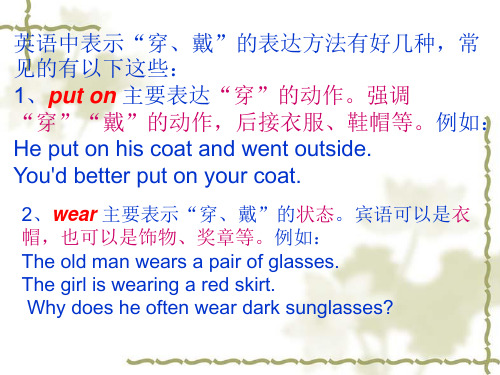
4、be in 表示穿着的状态后接表示衣服或颜色的词, 着重于服装的款式或颜色。它所构成的短语只能作 表语或定语。 。如: John is in white today. The man in black is a football coach.
have on的意思是“穿着,戴着”,例如: If you're wearing black pants you should have on black shoes and a black belt. I’ll have on black pants and a gray shirt tomorrow.
ቤተ መጻሕፍቲ ባይዱ
3、dress的宾语通常是人,意思是“给……穿衣服”。
dress oneself 或 get dressed表示给自己穿衣服。如: Please dress the children right now. My son is now able to dress himself. It’s time to wake up and get dressed!
be dressed in 的意思是“穿着”,表示状态。 She is dressed in a fur coat. The woman always dresses in green.
dress up的意思是“盛装打扮、乔装打扮 I’d like you to dress up for my birthday party tonight. 。
英语中表示“穿、戴”的表达方法有好几种,常 见的有以下这些: 1、put on 主要表达“穿”的动作。强调 “穿”“戴”的动作,后接衣服、鞋帽等。例如: He put on his coat and went outside. You'd better put on your coat.
穿的几种用法

put on, pull on, wear,have on , dress,in的用法区别(1)put on 穿上;戴上。
相当于及物动词,以衣物作宾语,着重于穿、戴的动作。
①It’s cold outside.You’d better put on your hat.外面很冷,你最好戴上帽子。
②She put on her coat and went out of the room hurriedly.她穿上大衣,匆忙地走了。
(2)wear (=have on)穿着;戴着。
相当于及物动词,有衣物作宾语,着重于穿、戴的状态。
have on不用于进行时态。
①He always wears/has on black shoes.她一直穿着黑鞋。
②She is wearing/has on a red coat她穿着红大衣。
(3)dress 穿;戴。
可用作及物动词,以人作宾语,即dress sb. (给某人穿衣);也可用作不及物动词。
既可强调动作,又可表示状态,表示状态时常用be dressed in 结构。
此外dress还可用作名词。
①Mary is dressing her daughter.玛丽正给她女儿穿衣服。
②She usually dresses well.她总是穿得很好。
③He is dressed in a black jacket.他穿着黑上衣。
(4)in 穿着;戴着。
是介词,以衣物或表示颜色的名词作宾语,表示状态。
构成的介词短词可作表语或定语。
①My brother is in a blue jacket.我弟弟穿着蓝上衣。
②The boy in a blue jacket is my brother.穿蓝上衣的孩子是我弟弟。
③My brother is in blue.我弟弟穿着蓝衣服。
dresss,wear,put_on,have_on的用法有什么区别

dresss, wear,put on, have on的用法有什么区别in,put on,wear,dress, have on, pull on 用法辨析都含有“穿、戴”之意,但用法不同。
in是介词,后接表示衣服或颜色的词,着重于服装的款式或颜色。
它所构成的短语只能作表语或定语。
例如:This is a picture of a young man in a black coat.这是一张穿着黑色外套的年轻人的照片。
这里in a black coat是young man的定语。
He is in a black nylon jacket today. 今天他穿着黑色尼龙夹克。
In a black nylon jacket在这个句子里作表语。
put on “穿上、戴上”,强调“穿”“戴”的动作,后接衣服、鞋帽等。
例如:I want you to put on this coat and this hat.我要你穿这件外套,戴这顶帽子。
Put on your heavy winter coat if you are going out.如果你要出去,穿上你的厚冬衣。
pull on的意思也是“穿上”,带有“匆忙”的意思:It’s the weekend. I know you’re free. So pull on your jeans and come out with me.现在是周末,我知道你有空。
所以穿上你的牛仔裤,和我一起出去吧。
You’re late! Quickly pull on your clothes and leave! 你迟到了!快穿上衣服走吧!wear “穿着;戴着”,表示状态,宾语可以是衣帽,也可以是饰物、奖章等。
例如:You’d better wear blue or black pants with blown shoes.穿棕色鞋子的时候, 最好要穿蓝色或黑色裤子。
put on ,in ,wear ,dress的用法及区别 -回复

put on ,in ,wear ,dress的用法及区别-回复"Put on," "in," "wear," and "dress" are all verbs used to describe the action of getting dressed or wearing clothing. While they have similar meanings, there are subtle differences in their usage and context.1. Put on:"Put on" is a phrasal verb commonly used to describe the action of physically donning clothes or accessories. It indicates the act of wearing something and emphasizes the action of placing the clothing on one's body. For example, you might say, "I put on my shoes before leaving the house." In this context, "put on" refers to the act of physically wearing or placing shoes on your feet.2. In:"In" is typically used to convey the idea of being inside or contained within clothing or accessories. For example, you might say, "She was dressed in a beautiful gown." Here, "in" implies that the person is wearing or dressed "inside" the gown. It emphasizes the state of being clothed in a particular garment.3. Wear:"Wear" is a verb used to describe the action of having something on one's body for an extended period, often as a common practice or part of one's routine. It implies a habitual orcontinuous action. For example, you might say, "I wear glasses every day." In this context, "wear" refers to the routine practice of having glasses on the face.4. Dress:"Dress" can function as both a noun and a verb. As a verb, it refers to the action of putting on clothes or getting dressed. It is a general term that encompasses the act of wearing clothes without specifying the manner or technique involved. For example, you might say, "I dress for work every morning," indicating the regular practice of putting on suitable attire for work.It is essential to note that while these verbs have overlapping meanings, their usage can vary based on context and personal preference. Here are some examples to further illustrate the differences:- "Please put on your jacket before going outside." (Emphasizing the action of physically wearing the jacket) - "She was dressed in a stylish suit for the business meeting." (Emphasizing the overall appearance or attire)- "I wear a hat to protect my head from the sun." (Implying a habitual practice or regular use)- "He dresses casually on weekends." (Referring to the overall practice or habit of wearing casual clothes)In conclusion, "put on," "in," "wear," and "dress" all relate to the act of getting dressed or wearing clothing. While they share similar meanings, their nuances distinguish them in terms of emphasis, style, and habitual practice. Understanding these subtle differences enhances communication and ensures accurate expression in everyday conversations.。
实用词汇:dress, wear, put on, have on, in的用法小结
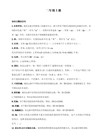
3.run as fast as you can.
big,large,huge用法区别 返回 | 分享 | 取消收藏
同学们,big,large和huge都可以用来形容“大”。今天我们就把3个单词排成一队,看看它们谁最大。
I want you to put on this coat and this hat.
我要你穿这件外套,戴这顶帽子。
Put on your heavy winter coat if you are going out.
如果你要出去,穿上你的厚冬衣。
3.wear “穿着;戴着”,表示状态,宾语可以是衣帽,也可以是饰物、奖章等。例如:
4.根据上下文进行适当的调整,确定所填词的正确性(词语所在位置对否)
5.再仔细阅读检查,对文章的时态、语态的理解,推敲句子的表达、语法及词语搭配等,进行调整和纠正。
六、短文改错
(A.仔细阅读题解合理利用符号; B.强调整体阅读。)
1.快速阅读,抓住中心思想,从整体上把握文章大意。
2.运用基础知识,从句型结构、词的变化、词类的选择、词的搭配、习惯表达出发,进行分析判断,找出错误。
四、阅读理解
全面检测学生接受书面信息和反馈能力的。考察方面有:理解词义,对句子的理解,对短文内容的推测,对文章理解判断能力,对主题句及中心的理解和归纳,找出最佳标题。
步骤如下:
1.通读全文,了解大意,推理生词意思 6-7%。
2.再次阅读,结合选项,抓住重点,各个击破。
3.开始解题,对照短文所提供的信息材料作出分析,
#能仿照学过的题材或话题(热点跟踪)
利用所给的范例写简单的书信、便条、通知等(功用性强与生活连接紧密的);能按要求笔头转述所听、所读的简单内容,并表达自己的观点。
put on ,in ,wear ,dress的用法及区别 -回复
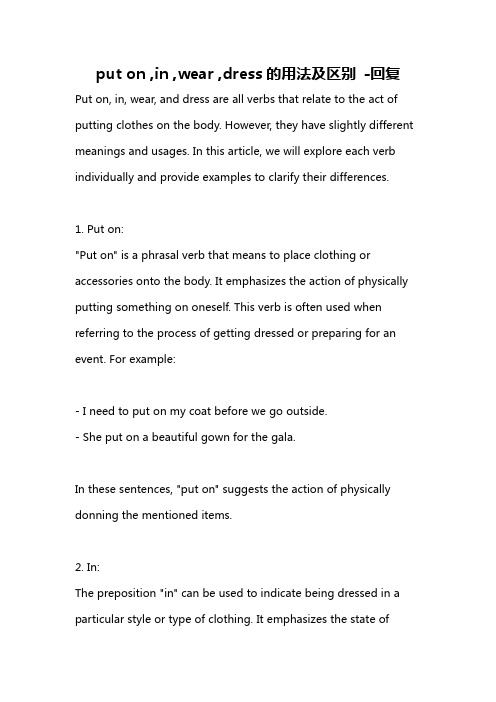
put on ,in ,wear ,dress的用法及区别-回复Put on, in, wear, and dress are all verbs that relate to the act of putting clothes on the body. However, they have slightly different meanings and usages. In this article, we will explore each verb individually and provide examples to clarify their differences.1. Put on:"Put on" is a phrasal verb that means to place clothing or accessories onto the body. It emphasizes the action of physically putting something on oneself. This verb is often used when referring to the process of getting dressed or preparing for an event. For example:- I need to put on my coat before we go outside.- She put on a beautiful gown for the gala.In these sentences, "put on" suggests the action of physically donning the mentioned items.2. In:The preposition "in" can be used to indicate being dressed in a particular style or type of clothing. It emphasizes the state ofwearing something. This preposition is often used when describing someone's outfit or appearance. For example:- He came in a black suit.- She looked stunning in that red dress.In these examples, "in" highlights the clothing that the person is already wearing.3. Wear:"Wear" is a verb that describes the act of having or putting on clothes. It emphasizes the ongoing state of having something on one's body or regularly using specific clothing items for a particular purpose. This verb can also be used when referring to accessories, such as jewelry or glasses. For example:- I like to wear comfortable clothes when I'm at home.- He always wears a watch to keep track of time.In these sentences, "wear" indicates the habitual or continuous state of having certain clothing items.4. Dress:"Dress" is a verb that primarily means to put on clothes. However, it often implies a more formal or intentional act of getting dressed up for a specific occasion. This verb can also refer to the act of wearing a certain style of clothing. For example:- She dressed carefully for her job interview.- He always dresses casually on weekends.In these sentences, "dress" suggests a deliberate selection of clothing for a specific purpose or event.While the meanings of "put on," "in," "wear," and "dress" may overlap to some extent, their subtle differences lie in the specific nuances they convey. "Put on" emphasizes the action of physically donning clothes, "in" emphasizes the state of wearing something, "wear" highlights the ongoing or habitual act of having clothes on the body, and "dress" implies a deliberate choice or dressing up for a particular occasion.It is worth noting that these verbs can be used interchangeably in some contexts, depending on the desired emphasis or thespeaker's personal style. Native speakers often choose the verb that best fits the intended meaning and context of the sentence.In conclusion, "put on," "in," "wear," and "dress" all relate to the act of clothing oneself, but with slight variations in meaning and usage. By understanding these differences, one can use these verbs appropriately and effectively when describing dressing and wearing clothes.。
“穿衣”用英语的几种表达
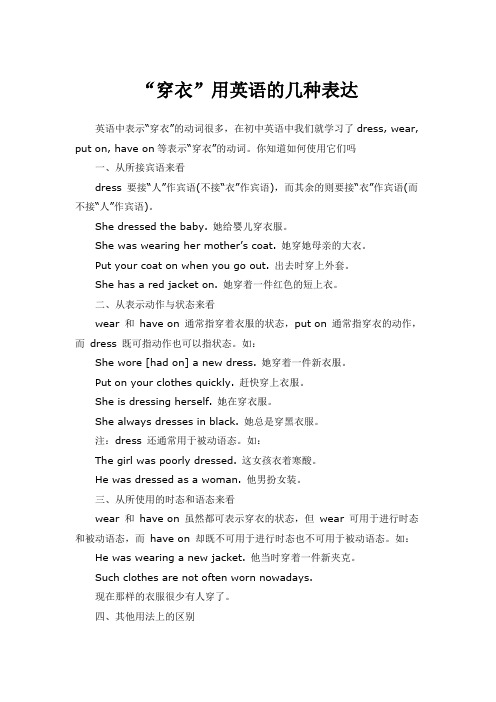
“穿衣”用英语的几种表达英语中表示“穿衣”的动词很多,在初中英语中我们就学习了dress, wear, put on, have on等表示“穿衣”的动词。
你知道如何使用它们吗一、从所接宾语来看dress 要接“人”作宾语(不接“衣”作宾语),而其余的则要接“衣”作宾语(而不接“人”作宾语)。
She dressed the baby. 她给婴儿穿衣服。
She was wearing her mother’s coat. 她穿她母亲的大衣。
Put your coat on when you go out. 出去时穿上外套。
She has a red jacket on. 她穿着一件红色的短上衣。
二、从表示动作与状态来看wear 和have on 通常指穿着衣服的状态,put on 通常指穿衣的动作,而dress 既可指动作也可以指状态。
如:She wore [had on] a new dress. 她穿着一件新衣服。
Put on your clothes quickly. 赶快穿上衣服。
She is dressing herself. 她在穿衣服。
She always dresses in black. 她总是穿黑衣服。
注:dress 还通常用于被动语态。
如:The girl was poorly dressed. 这女孩衣着寒酸。
He was dressed as a woman. 他男扮女装。
三、从所使用的时态和语态来看wear 和have on 虽然都可表示穿衣的状态,但wear 可用于进行时态和被动语态,而have on 却既不可用于进行时态也不可用于被动语态。
如:He was wearing a new jacket. 他当时穿着一件新夹克。
Such clothes are not often worn nowadays.现在那样的衣服很少有人穿了。
四、其他用法上的区别wear 除可表示穿衣外,还可表示戴表(花、纪念章等)以及留头发或胡须等,而dress, put on 一般不这样用。
英语穿衣的用法
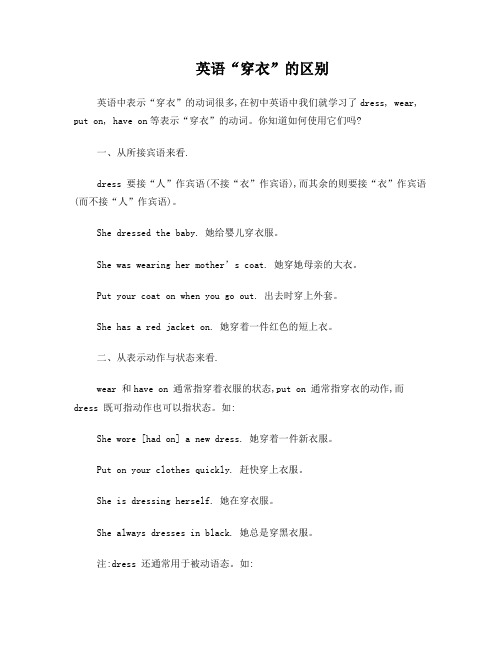
英语“穿衣”的区别英语中表示“穿衣”的动词很多,在初中英语中我们就学习了dress, wear, put on, have on等表示“穿衣”的动词。
你知道如何使用它们吗?一、从所接宾语来看.dress 要接“人”作宾语(不接“衣”作宾语),而其余的则要接“衣”作宾语(而不接“人”作宾语)。
She dressed the baby. 她给婴儿穿衣服。
She was wearing her mother’s coat. 她穿她母亲的大衣。
Put your coat on when you go out. 出去时穿上外套。
She has a red jacket on. 她穿着一件红色的短上衣。
二、从表示动作与状态来看.wear 和have on 通常指穿着衣服的状态,put on 通常指穿衣的动作,而dress 既可指动作也可以指状态。
如:She wore [had on] a new dress. 她穿着一件新衣服。
Put on your clothes quickly. 赶快穿上衣服。
She is dressing herself. 她在穿衣服。
She always dresses in black. 她总是穿黑衣服。
注:dress 还通常用于被动语态。
如:The girl was poorly dressed. 这女孩衣着寒酸。
He was dressed as a woman. 他男扮女装。
三、从所使用的时态和语态来看.wear 和have on 虽然都可表示穿衣的状态,但wear 可用于进行时态和被动语态,而have on 却既不可用于进行时态也不可用于被动语态。
如:He was wearing a new jacket. 他当时穿着一件新夹克。
Such clothes are not often worn nowadays. 现在那样的衣服很少有人穿了。
四、其他用法上的区别1wear 除可表示穿衣外,还可表示戴表(花、纪念章等)以及留头发或胡须等,而dress, put on 一般不这样用。
dress的用法
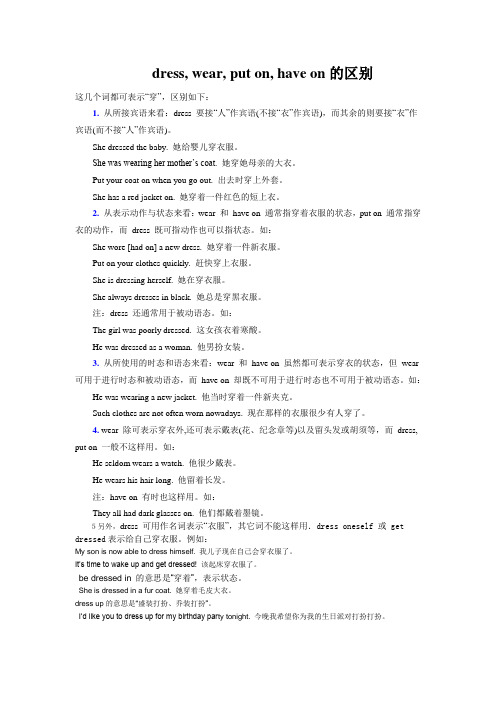
dress, wear, put on, have on的区别这几个词都可表示“穿”,区别如下:1.从所接宾语来看:dress 要接“人”作宾语(不接“衣”作宾语),而其余的则要接“衣”作宾语(而不接“人”作宾语)。
She dressed the baby. 她给婴儿穿衣服。
She was wearing her mother’s coat. 她穿她母亲的大衣。
Put your coat on when you go out. 出去时穿上外套。
She has a red jacket on. 她穿着一件红色的短上衣。
2.从表示动作与状态来看:wear 和have on 通常指穿着衣服的状态,put on 通常指穿衣的动作,而dress 既可指动作也可以指状态。
如:She wore [had on] a new dress. 她穿着一件新衣服。
Put on your clothes quickly. 赶快穿上衣服。
She is dressing herself. 她在穿衣服。
She always dresses in black. 她总是穿黑衣服。
注:dress 还通常用于被动语态。
如:The girl was poorly dressed. 这女孩衣着寒酸。
He was dressed as a woman. 他男扮女装。
3.从所使用的时态和语态来看:wear 和have on 虽然都可表示穿衣的状态,但wear 可用于进行时态和被动语态,而have on 却既不可用于进行时态也不可用于被动语态。
如:He was wearing a new jacket. 他当时穿着一件新夹克。
Such clothes are not often worn nowadays. 现在那样的衣服很少有人穿了。
4. wear 除可表示穿衣外,还可表示戴表(花、纪念章等)以及留头发或胡须等,而dress, put on 一般不这样用。
中考英语常用短语的区别与运用整理
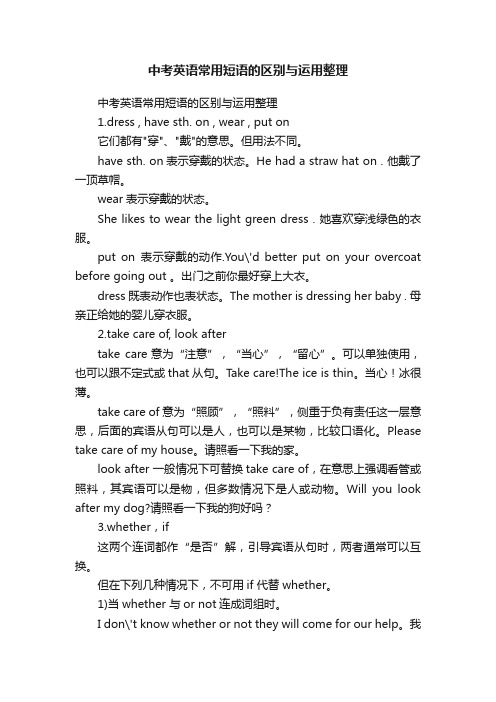
中考英语常用短语的区别与运用整理中考英语常用短语的区别与运用整理1.dress , have sth. on , wear , put on它们都有"穿"、"戴"的意思。
但用法不同。
have sth. on表示穿戴的状态。
He had a straw hat on . 他戴了一顶草帽。
wear表示穿戴的状态。
She likes to wear the light green dress . 她喜欢穿浅绿色的衣服。
put on表示穿戴的动作.You\'d better put on your overcoat before going out 。
出门之前你最好穿上大衣。
dress既表动作也表状态。
The mother is dressing her baby . 母亲正给她的婴儿穿衣服。
2.take care of, look aftertake care意为“注意”,“当心”,“留心”。
可以单独使用,也可以跟不定式或that从句。
Take care!The ice is thin。
当心!冰很薄。
take care of意为“照顾”,“照料”,侧重于负有责任这一层意思,后面的宾语从句可以是人,也可以是某物,比较口语化。
Please take care of my house。
请照看一下我的家。
look after 一般情况下可替换take care of,在意思上强调看管或照料,其宾语可以是物,但多数情况下是人或动物。
Will you look after my dog?请照看一下我的狗好吗?3.whether,if这两个连词都作“是否”解,引导宾语从句时,两者通常可以互换。
但在下列几种情况下,不可用if 代替whether。
1)当whether 与or not连成词组时。
I don\'t know whether or not they will come for our help。
put on ,in ,wear ,dress的用法及区别 -回复
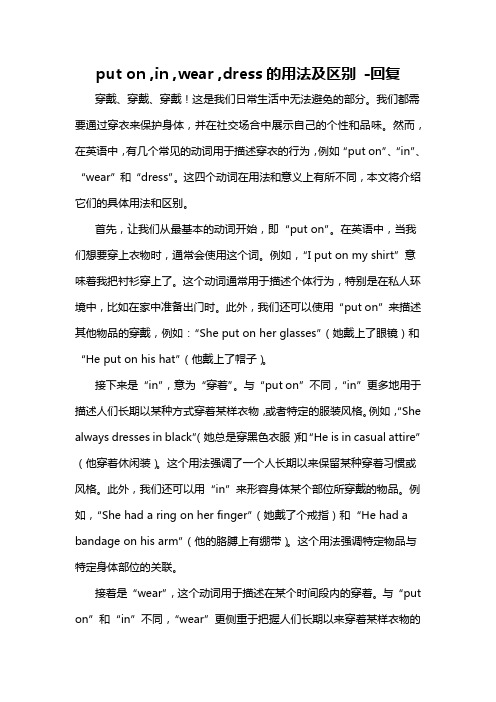
put on ,in ,wear ,dress的用法及区别-回复穿戴、穿戴、穿戴!这是我们日常生活中无法避免的部分。
我们都需要通过穿衣来保护身体,并在社交场合中展示自己的个性和品味。
然而,在英语中,有几个常见的动词用于描述穿衣的行为,例如“put on”、“in”、“wear”和“dress”。
这四个动词在用法和意义上有所不同,本文将介绍它们的具体用法和区别。
首先,让我们从最基本的动词开始,即“put on”。
在英语中,当我们想要穿上衣物时,通常会使用这个词。
例如,“I put on my shirt”意味着我把衬衫穿上了。
这个动词通常用于描述个体行为,特别是在私人环境中,比如在家中准备出门时。
此外,我们还可以使用“put on”来描述其他物品的穿戴,例如:“She put on her glasses”(她戴上了眼镜)和“He put on his hat”(他戴上了帽子)。
接下来是“in”,意为“穿着”。
与“put on”不同,“in”更多地用于描述人们长期以某种方式穿着某样衣物,或者特定的服装风格。
例如,“She always dresses in black”(她总是穿黑色衣服)和“He is in casual attire”(他穿着休闲装)。
这个用法强调了一个人长期以来保留某种穿着习惯或风格。
此外,我们还可以用“in”来形容身体某个部位所穿戴的物品。
例如,“She had a ring on her finger”(她戴了个戒指)和“He had a bandage on his arm”(他的胳膊上有绷带)。
这个用法强调特定物品与特定身体部位的关联。
接着是“wear”,这个动词用于描述在某个时间段内的穿着。
与“put on”和“in”不同,“wear”更侧重于把握人们长期以来穿着某样衣物的情况。
例如,“She often wears jeans”(她经常穿牛仔裤)和“He always wears a suit to work”(他总是穿西装上班)。
dress-wear put on have on in pull on用法区别
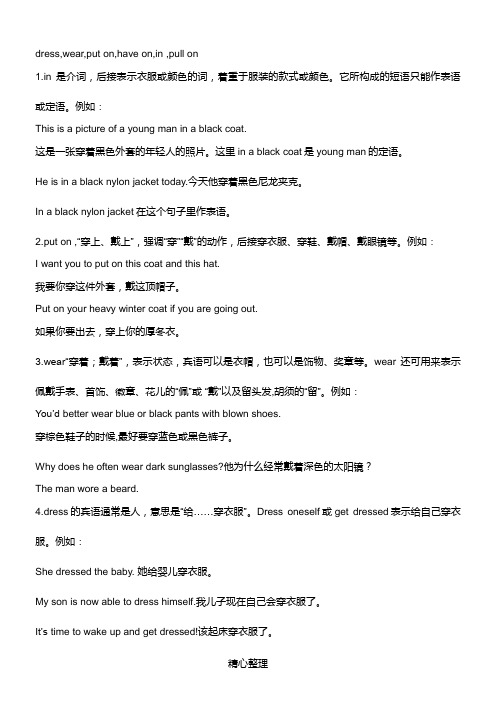
dress,wear,put on,have on,in ,pull on1.in是介词,后接表示衣服或颜色的词,着重于服装的款式或颜色。
它所构成的短语只能作表语或定语。
例如:This is a picture of a young man in a black coat.这是一张穿着黑色外套的年轻人的照片。
这里in a black coat是young man的定语。
He is in a black nylon jacket today.今天他穿着黑色尼龙夹克。
In a black nylon jacket在这个句子里作表语。
2.put on ,“穿上、戴上”,强调“穿”“戴”的动作,后接穿衣服、穿鞋、戴帽、戴眼镜等。
例如:I want you to put on this coat and this hat.我要你穿这件外套,戴这顶帽子。
Put on your heavy winter coat if you are going out.如果你要出去,穿上你的厚冬衣。
3.wear“穿着;戴着”,表示状态,宾语可以是衣帽,也可以是饰物、奖章等。
wear 还可用来表示佩戴手表、首饰、徽章、花儿的“佩”或“戴”以及留头发,胡须的“留”。
例如:You’d better wear blue or black pants with blown shoes.穿棕色鞋子的时候,最好要穿蓝色或黑色裤子。
Why does he often wear dark sunglasses?他为什么经常戴着深色的太阳镜?The man wore a beard.4.dress的宾语通常是人,意思是“给……穿衣服”。
Dress oneself或get dressed表示给自己穿衣服。
例如:She dressed the baby. 她给婴儿穿衣服。
My son is now able to dress himself.我儿子现在自己会穿衣服了。
穿衣用英语的几种表达

穿衣用英语的几种表达 Prepared on 24 November 2020“穿衣”用英语的几种表达英语中表示“穿衣”的动词很多,在初中英语中我们就学习了dress, wear, put on, have on等表示“穿衣”的动词。
你知道如何使用它们吗一、从所接宾语来看dress 要接“人”作宾语(不接“衣”作宾语),而其余的则要接“衣”作宾语(而不接“人”作宾语)。
She dressed the baby. 她给婴儿穿衣服。
She was wearing her mother’s coat. 她穿她母亲的大衣。
Put your coat on when you go out. 出去时穿上外套。
She has a red jacket on. 她穿着一件红色的短上衣。
二、从表示动作与状态来看wear 和 have on 通常指穿着衣服的状态,put on 通常指穿衣的动作,而 dress 既可指动作也可以指状态。
如:She wore [had on] a new dress. 她穿着一件新衣服。
Put on your clothes quickly. 赶快穿上衣服。
She is dressing herself. 她在穿衣服。
She always dresses in black. 她总是穿黑衣服。
注:dress 还通常用于被动语态。
如:The girl was poorly dressed. 这女孩衣着寒酸。
He was dressed as a woman. 他男扮女装。
三、从所使用的时态和语态来看wear 和 have on 虽然都可表示穿衣的状态,但 wear 可用于进行时态和被动语态,而 have on 却既不可用于进行时态也不可用于被动语态。
如:He was wearing a new jacket. 他当时穿着一件新夹克。
Such clothes are not often worn nowadays.现在那样的衣服很少有人穿了。
“穿衣”用英语的几种表达
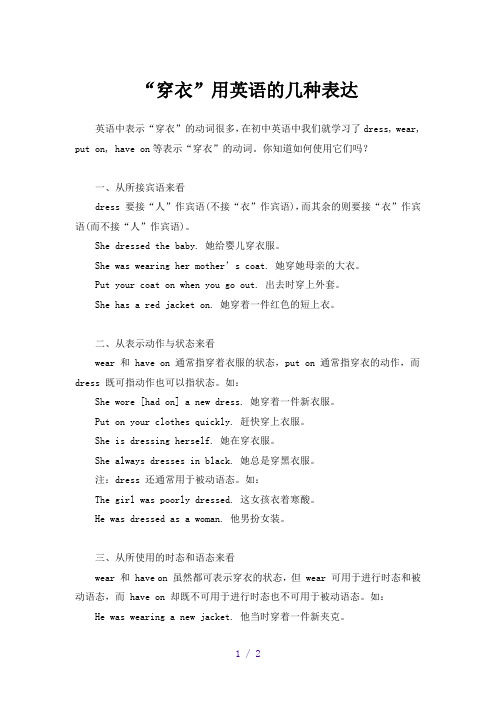
“穿衣”用英语的几种表达英语中表示“穿衣”的动词很多,在初中英语中我们就学习了dress, wear, put on, have on等表示“穿衣”的动词。
你知道如何使用它们吗?一、从所接宾语来看dress 要接“人”作宾语(不接“衣”作宾语),而其余的则要接“衣”作宾语(而不接“人”作宾语)。
She dressed the baby. 她给婴儿穿衣服。
She was wearing her mother’s coat. 她穿她母亲的大衣。
Put your coat on when you go out. 出去时穿上外套。
She has a red jacket on. 她穿着一件红色的短上衣。
二、从表示动作与状态来看wear 和 have on 通常指穿着衣服的状态,put on 通常指穿衣的动作,而dress 既可指动作也可以指状态。
如:She wore [had on] a new dress. 她穿着一件新衣服。
Put on your clothes quickly. 赶快穿上衣服。
She is dressing herself. 她在穿衣服。
She always dresses in black. 她总是穿黑衣服。
注:dress 还通常用于被动语态。
如:The girl was poorly dressed. 这女孩衣着寒酸。
He was dressed as a woman. 他男扮女装。
三、从所使用的时态和语态来看wear 和 have on 虽然都可表示穿衣的状态,但 wear 可用于进行时态和被动语态,而 have on 却既不可用于进行时态也不可用于被动语态。
如:He was wearing a new jacket. 他当时穿着一件新夹克。
1 / 2Such clothes are not often worn nowadays.现在那样的衣服很少有人穿了。
四、其他用法上的区别wear 除可表示穿衣外,还可表示戴表(花、纪念章等)以及留头发或胡须等,而 dress, put on 一般不这样用。
put on ,in ,wear ,dress的用法及区别

put on ,in ,wear ,dress的用法及区别1.引言1.1 概述在日常英语中,我们常常会用到一些表示穿着、穿戴的动词,如put on、in、wear和dress。
这些词语在表达方式上有一些区别,而且在具体用法上也存在一些差异。
本文将从put on、in、wear和dress四个方面详细探讨它们的用法和区别,并提供一些建议给学习者。
首先,我们将分别介绍每个词的意思和常见用法。
接着,我们将比较这些词与其他词的区别,从语义和语法两个角度进行分析。
最后,通过总结归纳,我们将对put on、in、wear和dress的用法和区别进行概括。
此外,我们还将为学习者提供一些建议,帮助他们更好地理解和运用这些词语。
本文的目的是帮助读者明确put on、in、wear和dress的用法,并能够准确地运用它们。
在学习英语的过程中,正确理解和使用这些词语将极大地提升口语和书面表达的准确性,并增加英语交流的流利性和自信心。
1.2 文章结构本文将从以下几个方面来探讨"put on"、"in"、"wear"和"dress"这几个词语的用法及区别。
首先,将简要介绍每个词的意思和常见用法,然后比较它们之间的差异和特点。
在文章的正文部分,将逐一展开讨论每个词语的用法和区别。
在"put on"的部分,会详细阐述其常见用法,并与其他词语进行对比,以帮助读者理解如何正确使用这个词。
接着,在"in"的部分,将介绍其常见用法,并强调与其他词的不同之处。
然后,会详细解释"wear"这个词的意思和常见用法,并与其他词进行对比。
最后,将探讨"dress"的用法和区别,介绍其常见用法,并指出相对于其他词语的独特之处。
在文章的结论部分,将对"put on"、"in"、"wear"和"dress"这几个词的用法和区别进行总结,简洁明了地概括它们之间的异同。
- 1、下载文档前请自行甄别文档内容的完整性,平台不提供额外的编辑、内容补充、找答案等附加服务。
- 2、"仅部分预览"的文档,不可在线预览部分如存在完整性等问题,可反馈申请退款(可完整预览的文档不适用该条件!)。
- 3、如文档侵犯您的权益,请联系客服反馈,我们会尽快为您处理(人工客服工作时间:9:00-18:30)。
我要你穿这件外套,戴这顶帽子。
Putonyourheavywintercoatifyouaregoingout.
如果你要出去,穿上你的厚冬衣。
3.wear“穿着;戴着”,表示状态,宾语可以是衣帽,也可以是饰物、奖章等。例如:
You’dbetterwearblueorblackpantswithblownshoes.
It’stimetowakeupandgetdressed!该起床穿衣服了。
bedressedin的意思是“穿着”,表示状态。
Sheisdressedinafurcoat.她穿着毛皮大衣。
5.dressup的意思是“盛装打扮、乔装打扮”。
I’dlikeyoutodressupformybirthdaypartytonight.
今晚我希望你为我的生日派对打扮打扮。
Youngkidsoftendressupandhavefห้องสมุดไป่ตู้natHalloween.
万圣节前夜,小孩子通常都乔装打扮,玩得很开心。
6.haveon的意思是“穿着,戴着”,例如:
Ifyou'rewearingblackpantsyoushouldhaveonblackshoesandablackbelt.
如果你穿着黑色长裤的话,你应该要穿黑色的鞋子,配黑色的皮带。
I’llhaveonblackpantsandagrayshirttomorrow.
明天我会穿一条黑色的长裤和一件灰色的衬衫。
这是一张穿着黑色外套的年轻人的照片。这里inablackcoat是youngman的定语。
Heisinablacknylonjackettoday.今天他穿着黑色尼龙夹克。
Inablacknylonjacket在这个句子里作表语。
2.puton?“穿上、戴上”,强调“穿”“戴”的动作,后接衣服、鞋帽等。例如:
穿棕色鞋子的时候,最好要穿蓝色或黑色裤子。
Whydoesheoftenweardarksunglasses?他为什么经常戴着深色的太阳镜?
4.dress的宾语通常是人,意思是“给……穿衣服”。dressoneself或getdressed表示给自己穿衣服。例如:
Mysonisnowabletodresshimself.我儿子现在自己会穿衣服了。
实用词汇:dress,wear,puton,haveon,in的用法小结
dress,wear,puton,haveon,in?都含有“穿、戴”之意,但用法不同。
1.in是介词,后接表示衣服或颜色的词,着重于服装的款式或颜色。它所构成的短语只能作表语或定语。例如:
Thisisapictureofayoungmaninablackcoat.
